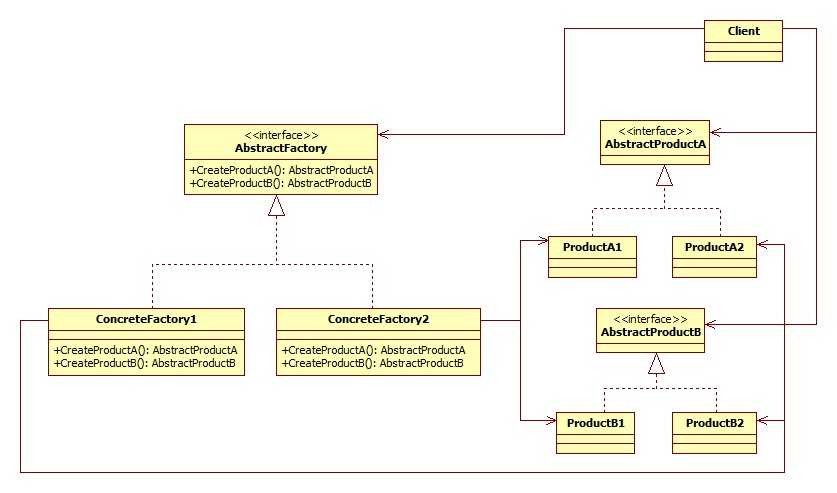标签:www. static product 角色 enc 动作 调用 根据 system
本文的套路:
提供一个接口,用于创建相关或依赖对象的家族,而不需要明确指定具体类。
前面【浅析设计模式(四)——创建型模式之Simple-Factory(简单工厂方法,非设计模式)】中介绍的简单工厂方法,虽然已经对变化的部分进行了封装,但是这里只由一个对象负责所有的具体类的实例化,因此每次有新增对象类型时,都需要改变工厂的源码进行扩展。而【浅析设计模式(五)——创建型模式之Factory-Method(工厂方法模式)】中介绍的工厂方法模式,则对简单工厂方法进行了最直接的封装和抽象,把创建对象的具体操作进行了分离,便于扩展和维护。这两种做法都是用于创建单类对象。
从某种角度来看,抽象工厂模式也是类似的,都是把创建对象的动作进行了封装。但是抽象工厂模式意在创建相关或依赖对象的家族。从抽象工厂模式的实现来看,它通过组合委托给具体的工厂来实现,对象的创建被实现在工厂接口所暴露出来的方法中,通常用于创建产品家族或者相关集合。而这些工厂通常使用工厂方法来实现具体的产品创建。做个最简化,如果抽象工厂也只是创建一类产品,而不考虑后续的扩展之类的,是可以直接用工厂方法来实现的。
这里有必要对“相关或依赖对象的家族”做一个简单地说明,举个栗子,假如要创建的对象是台电脑,那么像键盘、鼠标、显示器、主机等等,就可以看成是“相关或依赖对象的家族”。下面要举的栗子也是类似的,也还是拿Pizza的例子,Pizza有各种原料,这里从简,之举出Cheese奶酪、Veggies蔬菜、Clams蛤等原料进行说明,这里的创建对象,实际上是创建了包含各类原料的Pizza,也即就是提到的“相关或依赖对象的家族”。
1. AbstractFactory
2. ConcreteFactory
3. AbstractProduct
4. ConcreteProduct
5. Client

1. AbstractFactory:声明一个创建抽象产品对象的操作接口,用于创建相关或依赖对象的家族。
1 /** 2 * 3 * <p> 4 * Reference : Head-First-Design-Patterns 5 * 6 */ 7 public interface PizzaIngredientFactory { 8 public Cheese createCheese(); 9 public Veggies[] createVeggies(); 10 public Clams createClam(); 11 }
2. ConcreteFactory:实现创建具体产品对象的操作,这里就是最简单的直接创建对象,
例1:
1 /** 2 * 3 * <p> 4 * Reference : Head-First-Design-Patterns 5 * 6 */ 7 public class NYPizzaIngredientFactory implements PizzaIngredientFactory{ 8 9 @Override 10 public Veggies[] createVeggies() { 11 Veggies veggies[] = { new Garlic(), new Onion(), new Mushroom()}; 12 return veggies; 13 } 14 15 @Override 16 public Clams createClam() { 17 return new FreshClams(); 18 } 19 20 @Override 21 public Cheese createCheese() { 22 return new ReggianoCheese(); 23 } 24 }
例2
1 /** 2 * 3 * <p> 4 * Reference : Head-First-Design-Patterns 5 * 6 */ 7 public class ChicagoPizzaIngredientFactory implements PizzaIngredientFactory{ 8 9 @Override 10 public Cheese createCheese() { 11 return new MozzarellaCheese(); 12 } 13 @Override 14 public Veggies[] createVeggies() { 15 Veggies veggies[] = { new Onion(), new Garlic()}; 16 return veggies; 17 } 18 @Override 19 public Clams createClam() { 20 return new FrozenClams(); 21 } 22 }
从这里可以看出,上面的具体工厂其实就是工厂方法的简化,不带任何判断就直接创建了具体的对象。当然也是可以像前面提到的工厂方法模式一样,带参数,然后根据参数进行具体对象的创建。
3. AbstractProduct:为一类产品对象声明一个接口,以上创建的“相关或依赖对象的家族”其实就是这里需要用到的。
1 /** 2 * 3 * <p> 4 * Reference : Head-First-Design-Patterns 5 * 6 */ 7 public abstract class Pizza { 8 String name; 9 10 Veggies veggies[]; 11 Cheese cheese; 12 Clams clam; 13 14 abstract void prepare(); 15 16 void bake() { 17 System.out.println("Bake for 25 minutes at 350"); 18 } 19 20 void cut() { 21 System.out.println("Cutting the pizza into diagonal slices"); 22 } 23 24 void box() { 25 System.out.println("Place pizza in official PizzaStore box"); 26 } 27 28 void setName(String name) { 29 this.name = name; 30 } 31 32 String getName() { 33 return name; 34 } 35 36 public String toString() { 37 StringBuffer result = new StringBuffer(); 38 result.append("---- " + name + " ----\n"); 39 40 if (cheese != null) { 41 result.append(cheese); 42 result.append("\n"); 43 } 44 if (veggies != null) { 45 for (int i = 0; i < veggies.length; i++) { 46 result.append(veggies[i]); 47 if (i < veggies.length-1) { 48 result.append(", "); 49 } 50 } 51 result.append("\n"); 52 } 53 if (clam != null) { 54 result.append(clam); 55 result.append("\n"); 56 } 57 return result.toString(); 58 } 59 }
4. ConcreteProduct:实现AbstractProduct接口,定义一个将被相应的具体工厂创建的产品对象。
这里简单地举个栗子即可,可以看到,这里组合使用了创建对象的工厂,然后根据需要由工厂创建具体的对象。
1 /** 2 * 3 * <p> 4 * Reference : Head-First-Design-Patterns 5 * 6 */ 7 public class VeggiePizza extends Pizza{ 8 PizzaIngredientFactory ingredientFactory; 9 10 public VeggiePizza(PizzaIngredientFactory ingredientFactory) { 11 this.ingredientFactory = ingredientFactory; 12 } 13 14 @Override 15 void prepare() { 16 System.out.println("Preparing " + name); 17 cheese = ingredientFactory.createCheese(); 18 veggies = ingredientFactory.createVeggies(); 19 } 20 }
类似的
1 /** 2 * 3 * <p> 4 * Reference : Head-First-Design-Patterns 5 * 6 */ 7 public class ClamPizza extends Pizza{ 8 PizzaIngredientFactory ingredientFactory; 9 10 public ClamPizza(PizzaIngredientFactory ingredientFactory) { 11 this.ingredientFactory = ingredientFactory; 12 } 13 14 void prepare() { 15 System.out.println("Preparing " + name); 16 cheese = ingredientFactory.createCheese(); 17 clam = ingredientFactory.createClam(); 18 } 19 }
5. Client:仅使用由AbstractFactory和AbstractProduct类声明的接口。
这里的例子曲折了点,不过也可以大概说明要表达的意思。获取到具体Pizza的流程如下:
1 void prepare() { 2 System.out.println("Preparing " + name); 3 cheese = ingredientFactory.createCheese(); 4 //...其他的原料产品,如Veggies、Clams等,可能只需要一个,也可能全部都要。这里略去 5 }
顺着这个思路走:
PizzaStore nyStore = new NYPizzaStore() →
Pizza pizza = nyStore.orderPizza("cheese") →
Pizza pizza = createPizza("cheese") →
pizza = new CheesePizza(ingredientFactory) →
pizza.prepare() →
ingredientFactory创建具体的产品。。。
测试用的主类和主函数:
1 /** 2 * This is the test-main. 3 * <p> 4 * Reference : Head-First-Design-Patterns 5 * 6 */ 7 public class PizzaTestApp { 8 public static void main(String[] args) { 9 PizzaStore nyStore = new NYPizzaStore(); 10 PizzaStore chicagoStore = new ChicagoPizzaStore(); 11 12 Pizza pizza = nyStore.orderPizza("cheese"); 13 System.out.println("Ethan ordered a " + pizza + "\n"); 14 15 pizza = chicagoStore.orderPizza("cheese"); 16 System.out.println("Joel ordered a " + pizza + "\n"); 17 18 pizza = nyStore.orderPizza("clam"); 19 System.out.println("Ethan ordered a " + pizza + "\n"); 20 21 pizza = chicagoStore.orderPizza("clam"); 22 System.out.println("Joel ordered a " + pizza + "\n"); 23 24 25 pizza = nyStore.orderPizza("veggie"); 26 System.out.println("Ethan ordered a " + pizza + "\n"); 27 28 pizza = chicagoStore.orderPizza("veggie"); 29 System.out.println("Joel ordered a " + pizza + "\n"); 30 } 31 }
抽象类PizzaStore
1 /** 2 * 3 * <p> 4 * Reference : Head-First-Design-Patterns 5 * 6 */ 7 public abstract class PizzaStore { 8 protected abstract Pizza createPizza(String item); 9 10 public Pizza orderPizza(String type) { 11 Pizza pizza = createPizza(type); 12 System.out.println("--- Making a " + pizza.getName() + " ---"); 13 pizza.prepare(); 14 pizza.bake(); 15 pizza.cut(); 16 pizza.box(); 17 return pizza; 18 } 19 }
继承抽象类PizzaStore的具体实现类NYPizzaStore。
1 /** 2 * 3 * <p> 4 * Reference : Head-First-Design-Patterns 5 * 6 */ 7 public class NYPizzaStore extends PizzaStore{ 8 protected Pizza createPizza(String item) { 9 Pizza pizza = null; 10 PizzaIngredientFactory ingredientFactory = 11 new NYPizzaIngredientFactory(); 12 13 if (item.equals("cheese")) { 14 15 pizza = new CheesePizza(ingredientFactory); 16 pizza.setName("New York Style Cheese Pizza"); 17 18 } else if (item.equals("veggie")) { 19 20 pizza = new VeggiePizza(ingredientFactory); 21 pizza.setName("New York Style Veggie Pizza"); 22 23 } else if (item.equals("clam")) { 24 25 pizza = new ClamPizza(ingredientFactory); 26 pizza.setName("New York Style Clam Pizza"); 27 28 } 29 return pizza; 30 } 31 }
简单地总结,就是使用组合工厂类创建了包含一系列相关对象的具体产品对象。
参考
1、参考《Head First设计模式》和GoF《设计模式:可复用面向对象软件的基础》
2、代码可参考【github传送门】、UML类图参考【github传送门】
浅析设计模式(六)——创建型模式之Abstract-Factory(抽象工厂模式)
标签:www. static product 角色 enc 动作 调用 根据 system
原文地址:https://www.cnblogs.com/wpbxin/p/9237036.html